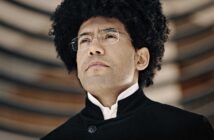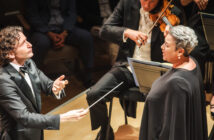Rachmaninov: Piano Concerto No. 1
Rachmaninov: Isle of the Dead
Rachmaninov: Piano Concerto No. 4
Kirill Gerstein, piano
Rachmaninov: Isle of the Dead
Rachmaninov: Piano Concerto No. 4
Kirill Gerstein, piano
Houston Symphony: Hans Graf, conductor
Jones Hall
Houston, Texas
Sunday, January 15, 2012
Houston, Texas
Sunday, January 15, 2012
Symphony orchestras frequently mount “festivals” to package their wares more effectively, but I can’t remember ever coming across a Rachmaninov Festival, or “RachFest,” as they called it in Houston.
 |
| Composer Sergei Rachmaninov |
There are usually two main reasons for classical music festivals: to celebrate artistic achievement and to fill seats.
Whereas Beethoven and Mozart festivals have become so common and in the beginning at least were so lucrative that artistic purposes were almost beside the point, in the case of Houston’ s more venturesome “RachFest,” I would guess that artistic and monetary motivations were about equal.
The Houston Symphony may have had a third reason for programming its Rachfest. Since much of Rachmaninov’s symphonic repertoire involves piano, such a festival potentially requires more than one outstanding soloist. In this department, Houston’s RachFest turned out to be as much as celebration of pianist Kirill Gerstein, as a tribute to Rachmaninov. Gerstein played all four piano concertos in a period of three weeks – quite a challenge for even the greatest of pianists!
RachFest Might Have been so Much More
As exciting as the concept was, I would suggest that the Houston Symphony’s celebration of Rachmaninov with a multi-concert festival could have been somewhat more imaginative.
To start with, two of Rachmaninov’s best works, Rhapsody on a Theme of Paganini and Symphony No. 2, were not included.
The Rachfest would also have provided an opportunity to showcase major Rachmaninov works such as The Bells and Vespers or, in cooperation with Houston Grand Opera or one of the local universities, one of the composer’s operas.
Why, I would ask, did the opening concert of RachFest open with Wagner’s Die Meistersinger Overture, rather than with one of the many shorter orchestral works by Rachmaninov?
Finally, I would suggest that more information on the Houston Symphony website, in the program book and in the lobby (posters, flyers etc.) would have significantly enriched the concert experience for many.
A Steady Beat Through Troubled Times
Maestro Hans Graf is now in his penultimate season as music director of the Houston Symphony, after which he assumes the title of Conductor Laureate. The consensus of opinion on his tenure appears to be that he has maintained the standard set by his predecessor Christoph Eschenbach.
Maestro Graf has lived through some tough years in Houston as the organization has struggled through a flood, a strike and the worst recession since the Great Depression. He may not have been the sort of charismatic leader who could bring new listeners to Jones Hall, but charismatic leaders are not always as sound musicians as Graf; in short, Graf has been a stabilizing influence for the Houston Symphony at a time when orchestras everywhere are floundering.
A Brilliant Rendition of Isle of the Dead
In this RachFest concert, Graf was not only an excellent partner for the amazing Mr. Gerstein in the piano concertos, he was also very impressive in one of Rachmaninov’s finest orchestral pieces, Isle of the Dead, which he introduced to the audience as the first performance of the work ever given by the Houston Symphony – an extraordinary oversight, given the importance of the piece.
Between 1880 and 1886, Swiss painter Arnold Böcklin did five versions of a painting he called “The Island of the Dead.” Before the downbeat, Maestro Graf directed the audience’s attention to a screen depicting one version of that painting, though not the specific one that had inspired Rachmaninov to compose Isle of the Dead.
This painting depicts a dark and rocky island with tombs on its cliffs. Approaching the island is a small boat in which we see a woman in a white shroud standing over a coffin. Böcklin never gave an explanation for the painting, leaving it to the viewer’s own imagination, and Rachmaninov has done the same with his tone poem Isle of the Dead, which opens with a musical evocation of the small boat rocking in the water as it moves toward the island. Bass instruments in a minor key and an unsettling 5/8 metre produce an appropriately dark sound for this long opening section, which gives way to a brighter more impassioned middle section, almost Wagnerian in its sweep as it builds inexorably towards a massive climax, returning finally to the morose music of the beginning.
Isle of the Dead is a magnificent piece that is surely one of Rachmaninov’s greatest achievements.
Hans Graf obviously loves this piece and gave a superb performance with the Houston Symphony, making the most of every detail, some of which were rendered by one of the world’s great horn players, William VerMeulen.The rich, golden colour of VerMuelen’s playing is inimitable and the unique expressiveness of his phrasing was ideal for the Isle of the Dead.
Channeling Rachmaninov: Graf and Gerstein Get it Right!
Last week, at RachFest’s opening concert, Gerstein had played the Piano Concerto No. 3. This week he paired the Piano Concertos Nos. 1 and 4, and next week he will conclude the festival with the Piano Concerto No. 2.
 |
| Kirill Gerstein (photo: Marco Borggreve) |
Rachmaninov composed his Piano Concerto No. 1 when he was still a teenager. It is a remarkable work for such a young composer. Understandably, while the composition draws inspiration from music by composers he admired as a youth, such as Liszt and Tchaikovsky, it already shows Rachmaninov’s growing mastery of the instrument and contains some wonderful original melodies. Gerstein played with the appropriate youthful energy and brought great beauty of tone to the quieter passages.
The Piano Concerto No. 4 was written 35 years after the first concerto and shows a remarkable stylistic evolution. By 1926, the world of music had changed drastically as composers like Schoenberg and Stravinsky experimented with greater chromaticism and complexity in their music. Rachmaninov couldn’t embrace all the new developments, but he was listening. The Piano Concerto No. 4 is indeed more chromatic than his earlier concertos and moves away from the big romantic tunes that were his bread and butter, towards the use of smaller motivic elements. Gerstein and Graf perfectly realized the modernity of this new style, engrossing the audience from beginning to end.
There are young pianists who dazzle audiences with speed and power; Gerstein is not one of them. Significantly, when asked in the Q and A after the concert to name the pianists he most admired, Gerstein named Radu Lupu and Rachmaninov, both pianists renowned for their musicianship rather than for their feats of pianistic gymnastics. Musicianship is what the performance of Rachmaninov’s music requires; while technically demanding, it requires, above all, beauty of tone and phrasing. Gerstein has it all.
A magnificent concert and a fine celebration of a great composer!
Encore a Nice Touch!
For an encore, Gerstein might have chosen to dazzle the audience with a Rachmaninov Prelude; instead, he and Graf sat down at the piano and played a charming early Rachmaninov Romance for four-hands.
For Those Wanting More…
In the Q and A after the concert, I asked Maestro Graf about Rachmaninov’s own recording of the Isle of the Dead with the Philadelphia Orchestra. While the performance is stunning, the composer himself made cuts in the score for this recording. While Maestro Graf admitted that the recording did prompt him to consider making those cuts himself, in the end, he could not bring himself to deviate from the published score.
I had a second question about the Piano Concerto No. 4 score, of which there are several versions, including one produced by the composer late in life and used for a recording with Ormandy in 1941. Which version had Gerstein and Graf used for this concert and why? Graf answered that there are things in the 1941 recording with Ormandy that are not in the score used for that recording, and that even after the recording, Rachmaninov continued to make changes.
Gerstein wrote a blog about the concerto for the Houston Symphony website, which includes the following comments: “Maestro Hans Graf and I have enjoyed correspondence about some of these late additions. Pianist and researcher Leslie Howard, kindly shared a copy of an autograph page, housed at the Library of Congress, for figures 74 to 76 of the 3rd movement. I am happy that our performance this weekend will include additional counterpoint lines that are usually omitted from performance.”
To Screen or Not to Screen – That is the Question
The Houston Symphony, like many other orchestras is making extensive use of large video screens to enhance the concert experience. In Jones Hall there are two large screens at the front of the hall on either side of the stage. The idea is to give the audience close-up views of the soloist, conductors and members of the orchestra during the performance. While I personally think this is a wonderful idea, others find it distracting. For me, it is a case of using new technology to enhance the concert experience.
Those who attended this performance may have noticed that only one of the screens was in use. Why? Krill Gerstein gave the answer in the Q and A after the concert. Sitting at the keyboard, Gerstein had the right side screen directly in his line of sight. He found it distracting to be watching himself while he played. It was even more disconcerting for him since there is a short delay between the actual performance and what appeared on the screen.
Houston Arts District Surprises and Delights
At this concert and at the Alley Theater production of The Toxic Avenger this same evening, representatives of American Express were handing out free CDs and food and beverage vouchers worth $10. These freebies were given to any patrons who could show an American Express card, as part of American Express’s imaginative “Surprise and Delight” campaign. At the Alley Theater performance, patrons were given a free CD featuring music from the show. Jones Hall gave members of the audience free Houston Symphony CDs. These promotions appear to have been very effective marketing ploys for both arts organizations and for American Express.
Breaking News
The Houston Symphony yesterday (January 24th) announced details of its 2012-2013 season. As mentioned above, this will be Hans Graf’s last season as music director.
One of this coming season’s highlights will surely be a concert performance of Berg’s opera Wozzeck conducted by Graf. His farewell concerts in May, 2013 will feature Mahler’s Symphony No. 2, Resurrection.
Paul E. Robinson is the author of Herbert von Karajan: the Maestro as Superstar, and Sir Georg Solti: His Life and Music. For friends: The Art of the Conductor podcast, Classical Airs.















